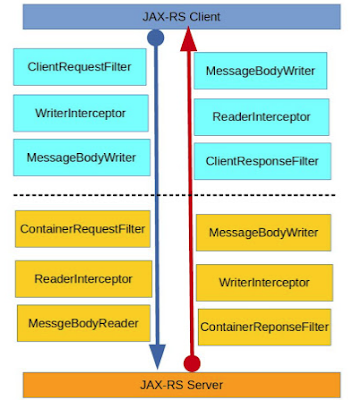As
Java Brains says we should distinguish several components that can be used both from client and server in order intercept the request or response and modify them.
1 Interceptors, Filters and MessageBody
- Interceptors manipulate entities (body) in input and output streams while filters only manipulate the request or response params like headers, URIs etc
- There are 2 kinds of interceptors ReaderInterceptor and WriterInterceptor. To create an interceptor, you should implement one of the 2 interfaces. One of the possible use is to GZip the body for slow communications.There are 2 kinds too of filters Container RequestFilters and ContainerResponseFilters one for the request and the other for the response. the basic usages are Logging, security..
- Filters and interceptors can work both on the client and server side.
- On the client side, we have these filters: ClientRequestFilter and ClientResponseFilter.
- We also have MessageBodyReader and MessageBodyWriter for the body manipulation.
Here is a schema of a Request and a Response and the order these elements interact
2. CDI Injection
JAX-RS Resources can be converted to Singleton and Stateless beans. This can be achieved by means of annotations. Here are some examples:
2.1 Stateless bean
1
2
3
| @Stateless
@Path("stateless-bean")
public class StatlesResource() {}
|
2.2 Singleton bean
1
2
3
| @Singleton
@Path("singleton-bean")
public class SingletonResource() {}
|
2.3 Request scoped bean
This is the default, so it is not necessary o annotate i
1
2
3
| @RequestScoped
@Path("/employee/{id}")
public class RequestScopedResource() {}
|
3. Conclusions
We have seen:
- Create a JAX-RS application that extends Application and may have an annotation @ApplicationPath("somePath")
- Created Resources with annotations like @Path(), @GET or @Produces
- Resource lifecycle, Singleton etc.
- Custom PartamConverters that implement ParamConverterProviders and provide a class conversion. The annotation used is @Provider and should implement ParamConverterProvider interface.
- MessageBodyReaders and MessageBodyWriters to convert data types that should implement the correspònding interface and use the @Provider annotation.
- Create our own Custom Media Types with the annotation @Produces in the MessageBodyWriter
- Created a JAX-RS client with ClientBuilder and make a request and response.
- Used WebTarget class to manipulate URLs and parameters as templates and assign parameters to produce client request.
- Created POST request and have seen how the Response class has some methods to see cookies, headers and so on.
- Can prepare request with the buildGet() method in the client (instead of get())
- We can also use the GenericType<> wrapper to get the elements of a response in the client
- Used Filters for Base Security implementation using header parameters Authentication Basic user:password
- We have seen about interceptors, Request and Response flows
- CDI (@Singleton, @Stateless, and default @RequestScoped)


Comentarios
Publicar un comentario